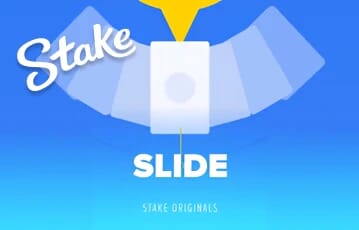The Stake Slide game is one of Stake.com's most underrated gems; it’s easy to play, fast-paced, and packed with decent win potential. It is a typical crash-style game where players predict how far the slide will go before it lands.
In this guide, you will learn how the game works, what makes it different from other crash games, and how to develop innovative strategies for balancing risk and reward. If you’re new to Stake.com, use the bonus code SPORTSGAMBLER to claim a 200% bonus of up to $2,000 to explore the game and other Stake Originals lineups.

Stake Slide is a high-RTP crash-style game exclusive to Stake.com, built around one core idea: you pick a multiplier and hope the game's slide lands on or above it. It is quick, intuitive, and wildly unpredictable, with payouts ranging from 1.01x to 4,294,967,000x your bet. Understanding how Stake Slide works is essential before diving in, especially if you want to avoid betting blindly.
| Feature | Description |
|---|---|
| Minimum bet | $0.01 (or equivalent in crypto) |
| Maximum payout | 4,294,967,000x your bet |
| Target multipliers | Range from 1.01x to 4.29B x |
| RTP (Return to Player) | 98% – high compared to other games |
| House edge | 2% |
| Volatility | Low, but customizable by multiplier choice |
At the heart of Stake Slide is a carousel of multiplier cards that spin from right to left every round. Once the countdown ends, the pointer randomly lands on one multiplier value. If your chosen target multiplier equals or exceeds that number, you win; your bet is multiplied by the value you selected.
You can place multiple wagers per round, each with a different multiplier, allowing you to hedge or target different reward levels.
There are two betting modes to choose from:
Manual mode: You select your bet amount and input your preferred target multiplier. Hit "Bet" to lock it in before the timer expires.
Auto mode: Here is where customization comes in. You can:
This flexibility is ideal for players who want to test strategies over time or avoid emotional betting decisions.
Understanding how Stake Slide works, especially across these two betting modes, gives you a clearer edge in how you approach risk on each round.



Stake Slide is built for speed and clarity. The interface splits the screen into two main areas, making navigation easy whether you are playing casually or grinding out dozens of rounds.
On the left side, you will find the betting panel. This is where you choose between Manual or Auto modes, input your stake, and set your target multiplier. The process is designed to be frictionless; even beginners will find it easy to follow.
On the right side, the game animation takes over. Here, you watch multiplier cards race past until one randomly stops under the pointer. That is your result.
What makes Stake Slide especially engaging is its multiplayer layer. You can see how many players are betting each round, which multipliers they have selected, and who wins, turning each round into a social moment.
The Auto Mode brings deeper functionality to the gameplay when playing this game. You can preset:
This is where the Stake Slide auto cash-out system comes into play. While there is no instant button like in Crash, the game lets you predefine when the auto mode should stop. For instance, you can tell it to quit after hitting a certain profit or if losses exceed a defined percentage.
Additionally, hotkeys are available for those on the desktop. This feature allows for faster gameplay by letting you place bets, toggle options, or repeat rounds without using a mouse. Something to take away is that Stake Slide's interface is responsive, modern, and strategically built for users who value both control and speed.
Since the game is completely random and provably fair, strategy is about controlling your decisions:
The point of the Stake Slide is choosing a target multiplier, which defines the round.
The risk/reward dynamics of the game are where you will often hear players debate the logic behind the slide game multiplier stake range. Instead of trying to land a 1000x win, many players build a hybrid plan: one small bet at a moonshot multiplier and a larger one at a safer range.
Here are strategic tips for playing the Slide game at Stake.com:
If you are just getting into Stake Slide, you want to avoid autoplay at first. This feature is best reserved for players who have learned the game's rhythm and understand how to wisely set profit/loss stops. Start slow, watch the slide results, and build your comfort with different multiplier tiers before locking in bulk rounds.

One of the most compelling aspects of Stake Slide is the raw payout potential, even for the smallest wagers. The multiplier ceiling sits at an astronomical 4,294,967,000x, so every bet carries theoretical firepower.
Below is a simple breakdown of how different multipliers affect a standard $1 stake:
| Bet amount | Multiplier | Potential return |
|---|---|---|
| $1 | 2x | $2 |
| $1 | 10x | $10 |
| $1 | 1,000x | $1,000 |
| $1 | 1,000,000x | $1,000,000 |
Stake Originals are known for delivering clean mechanics and high-stakes plays. Stake Slide fits right into that mold but with its own unique identity. Here is how it compares to other flagship Stake titles:
Crash is timing-based; you manually cash out before the crash point. In contrast, Stake Slide asks you to lock in a multiplier before the round starts. There is no reaction time, just pure prediction.
Limbo and Slide share the closest DNA. Both involve guessing a multiplier and if the result meets or beats your prediction, you win. But Slide takes it further with multiplayer visibility and broader bet tools.
Games like Stake Plinko add a physics-based twist. Outcomes are random but shaped by ball drops rather than raw multipliers. Meanwhile, Stake Pump leans heavily into multiplayer RNG chaos, which has a vibe similar to Slide.
For something more thematic, Tome of Life offers a narrative-driven gameplay loop but does not match Slide's raw payout volatility. Still, all four titles speak to Stake's talent for crafting exclusive, replayable games.
If you are looking for a game with serious payout potential and minimal house edge, Stake Slide delivers on both fronts. Here are the key stats:
As a new player, here are the benefits and shortcomings of playing Stake Slide:

Having read this guide to the end, it is evident that Stake Slide is a test of timing, self-control, and calculated risk. The game's beauty lies in its simplicity: pick a number and ride the odds. However, that simplicity hides a strategic depth that rewards sharp, disciplined play.
As noted, auto mode can speed things up, but without a stop-loss plan, it is a quick path to bankroll burn. If you are new to the game, high multipliers might look tempting, but chasing extremes without structure rarely pays off. Instead, you should understand the math, monitor your moves, and commit to a plan.
You can use any of the banners around this page to sign up to Stake.com and try the game for yourself. Input our exclusive code SPORTSGAMBLER to unlock a generous welcome bonus of 200% up to $2,000 or currency equivalent. Keep in mind that this offer may vary slightly depending on your location. Check our on-page banners for bonuses available in your area.

Slide uses RNG and a provably fair algorithm like the other Stake Originals games.
Stake.com supports various cryptocurrencies. You can bet with BTC, ETH, LTC, and more.
Slide is prediction-based, while Crash is reaction-based.
Most Stake Originals games feature demo modes. So, yes, you can play the game for free.
As a new or casual player, always bet small and scale multiplier conservatively. With time, you can start to mix multiple bets.





